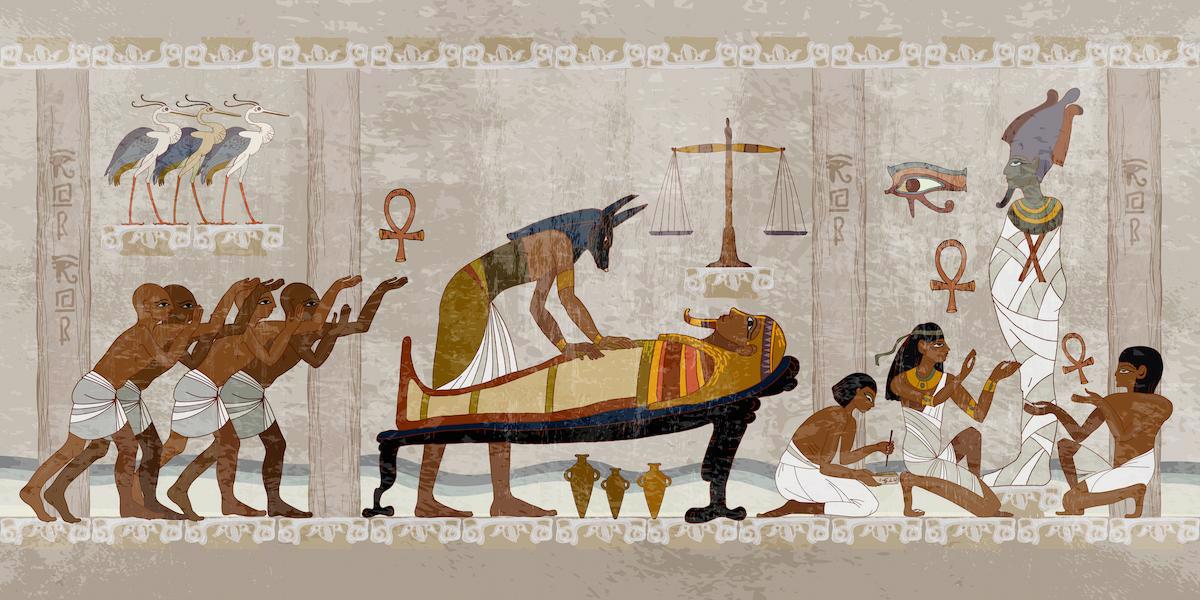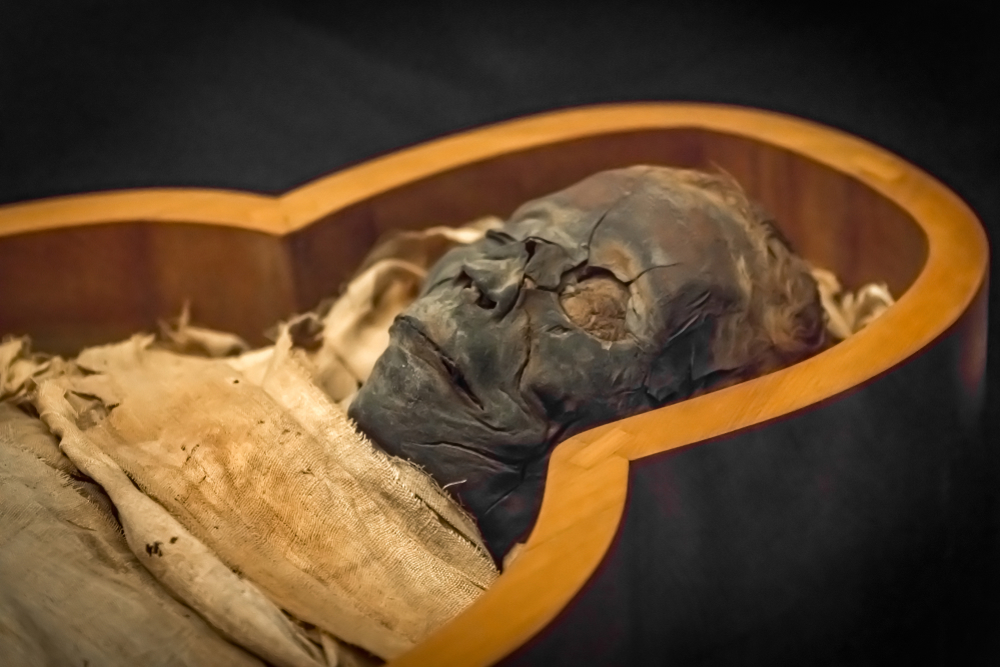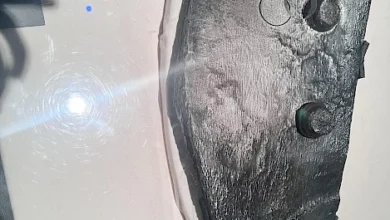Ancient Egyptians’ Mummification Recipe Revealed

From the “Kids, don’t try this at home” vault comes word that researchers studying ceramic pottery from an ancient Egyptian embalming workshop near one of the oldest pyramids ever made have discovered the magic formula for preserving human bodies used by Egyptian funeral directors. The ingredients list contains some surprises and shows the impressive amount of work they devoted to this mysterious process. Now that we think about it, this formula probably belongs in the “Adults, don’t’ try this at home” file as well. Let’s take a look at the ingredients and the instructions found at Saqqara for making a human body last forever.
“Ancient Egyptians developed an outstanding ability to protect the human body from decomposition or destruction after death—instigated by the belief that the decomposition of the corpse presented a physical obstacle toward attaining the afterlife15. Performed by specialized and learned individuals (ritualist embalmers), embalming was both a chemical and a ritual process.” (from “Biomolecular analyses enable new insights into ancient Egyptian embalming” in the journal Nature)

Mummies (or mummified bodies, now the preferred description) have fascinated archeologists and the rest of us since the exploration and exploitation of Egyptian tombs began centuries ago. Unwrapping and studying them did little to reveal the secrets of their embalming but had a lot to do with the push to end of the desecration of these human remains. As a result, new studies on the mummification processes have turned to the tools and containers found in tombs and eventually in ancient embalming facilities. One such workshop was discovered in 2016 at the necropolis of Saqqara, the ancient burial grounds of Memphis near the Pyramid of Djoser, more popularly known as the Step Pyramid. The workshop was found partly above ground but further exploration uncovered a shaft connected to an underground embalming room and burial chamber where what turned out to be the secrets of mummification were found.
“We analysed the organic contents of 31 ceramic vessels recovered from a 26th Dynasty embalming workshop at Saqqara. These vessels were labelled according to their content and/or use, enabling us to correlate organic substances with their Egyptian names and specific embalming practices.”
How convenient! The vessels found in the workshop were labeled, aiding study lead author Maxime Rageot, a biomolecular archaeologist at the University of Tübingen in Germany, and his team in their quest to solve the mysteries of Egyptian mummification. These ceramic containers dated as far back as 664 BCE, and many were also inscribed with instructions for using the contents in the embalming process – instructions such as “to put on his head” and “bandage with it.” Others even listed the name of the administrator of the embalming workshop. This discovery put the team far ahead of previous research which was limited to chemical analyses of mummies and their wrappings or scant historical records. These artifacts put the archeologists back in this room when it was an operational embalming facility 2700 years ago.
To determine the identity of the substances used, the team – made up of researchers from Germany and Egypt – analyzed the residues using a gas chromatography–mass spectrometer at a National Research Centre laboratory in Giza, Egypt. Gas chromatography–mass spectrometry is one of the most accurate analyses available for identifying different substances within a sample. The samples came from 9 beakers and 22 red bowls with the most clearly readable labels. One sample contained elemi resin, Pistacia tree resin, beeswax and by-products of juniper – the instructions on the jar revealed this was used for embalming the head. One bowl contained only animal fat, but the most common mixture was oil or tar of juniper/cypress and cedar, animal fat and/or plant oil and elemi – an aromatic essential oil from the same botanical family as frankincense and myrrh. The elemi and juniper/cypress usage was a new discovery for those studying the mummification process. The instructions on the jars were extremely helpful:
“Six other sherds provided information on substances used for washing the body, reducing bodily odour and softening the skin, as well as a recipe for the treatment of the liver and another for the stomach. The bowl labelled with ‘to wash’, contained markers of oil or tar of conifer, and the bowl inscribed with ‘to make his odour pleasant’ showed evidence of ruminant animal fat (adipose or dairy) and degraded Burseraceae resin. In the vessel with inscriptions related to the treatment of the skin, which may have occurred on the third day of embalming, we identified a mixture of animal ruminant fat (adipose or dairy) combined with heated beeswax.”
The wide variety of substances used for mummification at the Saqqara workshop yielded a second surprise – most of them were imported … and often from distance regions. The bitumen most likely came from the Dead Sea. The resins from Pistacia trees, olive trees, cedar, juniper and cypress came from different locations in the Mediterranean basin areas. By-products from cedars of Lebanon (Cedrus libani) came from the Levant – the large area in the Eastern Mediterranean region of Western Asia. Perhaps the only local items were the beeswax and animal fats. This illustrated that the embalming process spurred a global economy and trade system centered in Egypt. Study co-author Professor Philipp Stockhammer pointed out that some tropical resins had been transported as far as Southeast Asia. However, he was most fascinated by the skills of these ancient embalmers.
“’I was fascinated by this chemical knowledge. In the embalming process the skin is immediately endangered by being colonized by microbes that would eat up the skin. These people used antibacterial and antifungal substances to keep the skin best preserved, but without having any microbiological background – without knowing about bacteria. My personal highlight was to see this enormous knowledge that has accumulated through centuries of experience of embalming.”

The discovery of both the substances and the practices of the mummification process highlighted the extensive chemistry and biology knowledge these ancient embalmers had. They knew that bitumen and beeswax sealed the skin’s pores and reduce moisture, and a covering of natron salt dried the body inside and out to help preserve the skin. However, the last missing piece in the mystery of mummification is still a mystery – how did these ancient embalmers discover the properties of these substances and perfect the recipes that persevered bodies so well for thousands of years? Study co-author Mahmoud Bahgat, a biochemist at Egypt’s National Research Centre in Cairo, offered a solution:
“We need to be as clever as them to discover the intentions.”
As clever as an Egyptian funeral embalmer – sounds like the start of a new adage.




